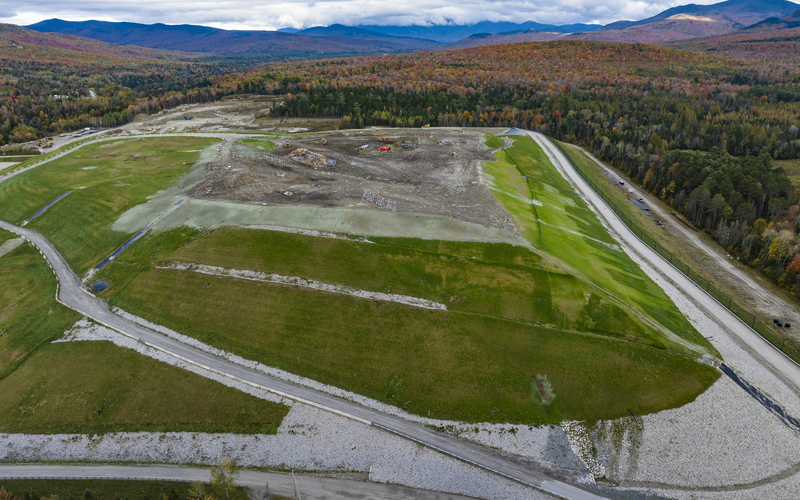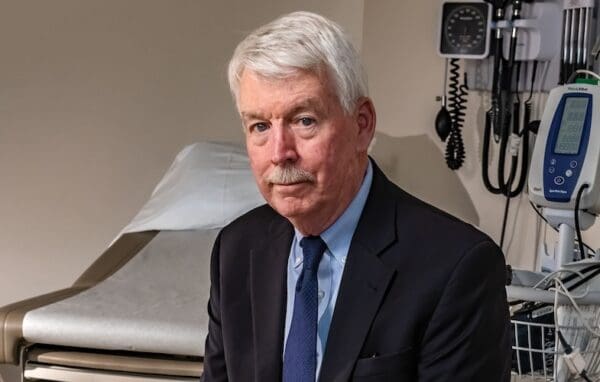
Landfills like this one in Bethlehem, New Hampshire, risk contaminating local waters with toxic "forever chemicals." Photo: EcoPhotography
Most people don’t realize that landfills, when working as intended, send poisonous chemicals into our waterways. Those chemicals – poly- and perfluorochemicals, or PFAS for short – are called “forever chemicals” because they do not break down in the environment or in our bodies. These toxic substances are linked to a growing number of health harms, including cancers, fertility issues, child development disorders, hormonal dysfunction, and damage to the thyroid, kidney, and liver.
Testing throughout New England has revealed PFAS contamination in groundwater and drinking water regionwide – and landfills are a major culprit in this pollution. That’s because when rain or snow seeps through buried trash in a landfill, it leaches – or draws out – chemicals and other pollutants, including alarming levels of PFAS. Landfills collect and send this PFAS-laden wastewater, called “leachate,” to treatment plants, which treat the leachate and pump it back into our waters.
Here’s the catch: Wastewater treatment plants do not treat the leachate for these toxic chemicals. So, this PFAS-filled “toxic stew” is continuously dumped back into our waters. This is the system all throughout the country, including New England.
This is a growing problem that needs to be addressed both at the wastewater treatment level and at the source – by preventing PFAS in products in the first place.
Where Things Stand: Vermont is Trying to Stop This Toxic Cycle
Vermont took a bold step in trying to halt this cycle of PFAS contamination at the state’s sole landfill, Coventry Landfill. Regulators required that the landfill owner, Casella Waste Systems, pilot a system to remove PFAS from their leachate before sending it to Vermont’s wastewater plants. CLF supported this move. But we also warned that the requirements the state laid out for Casella did not ensure enough agency oversight of the pilot project – and that would leave Vermonters vulnerable.
We were especially concerned after we worked with leading experts to thoroughly assess Casella’s plan for its pilot treatment program – and found it lacking. The proposed system is a new and unproven technology with serious limitations. The technology, foam fractionation, basically uses foam to capture certain PFAS. Casella then puts this toxic foam in cement and buries the cement in the landfill.
The biggest problems are that:
- Foam fractionation does not remove some of the most toxic kinds of PFAS, including a group of chemicals that the EPA will soon regulate. So even if the technology works for certain forever chemicals, it still leaves us vulnerable to many others.
- Foam fractionation does not remove PFAS “precursors.” These are basically chemicals that actually turn into dangerous and regulated PFAS once they go through a wastewater treatment plant. So treatment could actually result in more chemicals getting dumped into the nearest waterbody.
- Encasing PFAS-filled foam in cement, as Casella appears to be doing, makes it very likely those PFAS will leak out of the cement into the landfill – continuing this toxic leachate cycle.
In place of this ineffective system, Casella should use a series of treatments to remove the most PFAS possible. They should then use destruction technologies to destroy the chemicals in the leftover foam, not just recycle it back into the leachate stream.
CLF, in partnership with Just Zero, submitted extensive comments to the Vermont Department of Environmental Conservation, outlining these concerns and others. Alarmingly, even as we were preparing our extensive analysis, we discovered that Casella had already begun running their pilot system – without waiting for its plan to be reviewed, improved, or approved. We urged state regulators to halt the project until it had undergone full review and approval. They did not.
Last month, we found out that the treatment system had malfunctioned, allowing thousands of gallons of leachate to spill onto soil and across a road in the landfill. Effects of this spill are still being investigated, and the treatment system has been put on hold.
Next Steps: Treat Landfill Leachate for PFAS across New England, and Stop PFAS Upstream
Getting PFAS out of landfill wastewater isn’t easy – it’s expensive, complex, and evolving. That’s why we continue to push Vermont regulators to implement stricter controls over the Casella pilot project, including the use of more effective treatment technology. Vermont is leading the region in addressing this urgent issue. Other New England states are just beginning to grapple with how to treat PFAS in leachate. Vermont’s example highlights the importance of getting these treatment systems right, with full agency review and public input.
Of course, the best way to keep forever chemicals out of our streams, rivers, and bodies is to stop them at the source. That’s why we are pushing forward bills in New Hampshire and Vermont that ban PFAS in consumer products. These efforts are key to stopping the endless flow of these toxic forever chemicals. Anything less is too little, too late.



